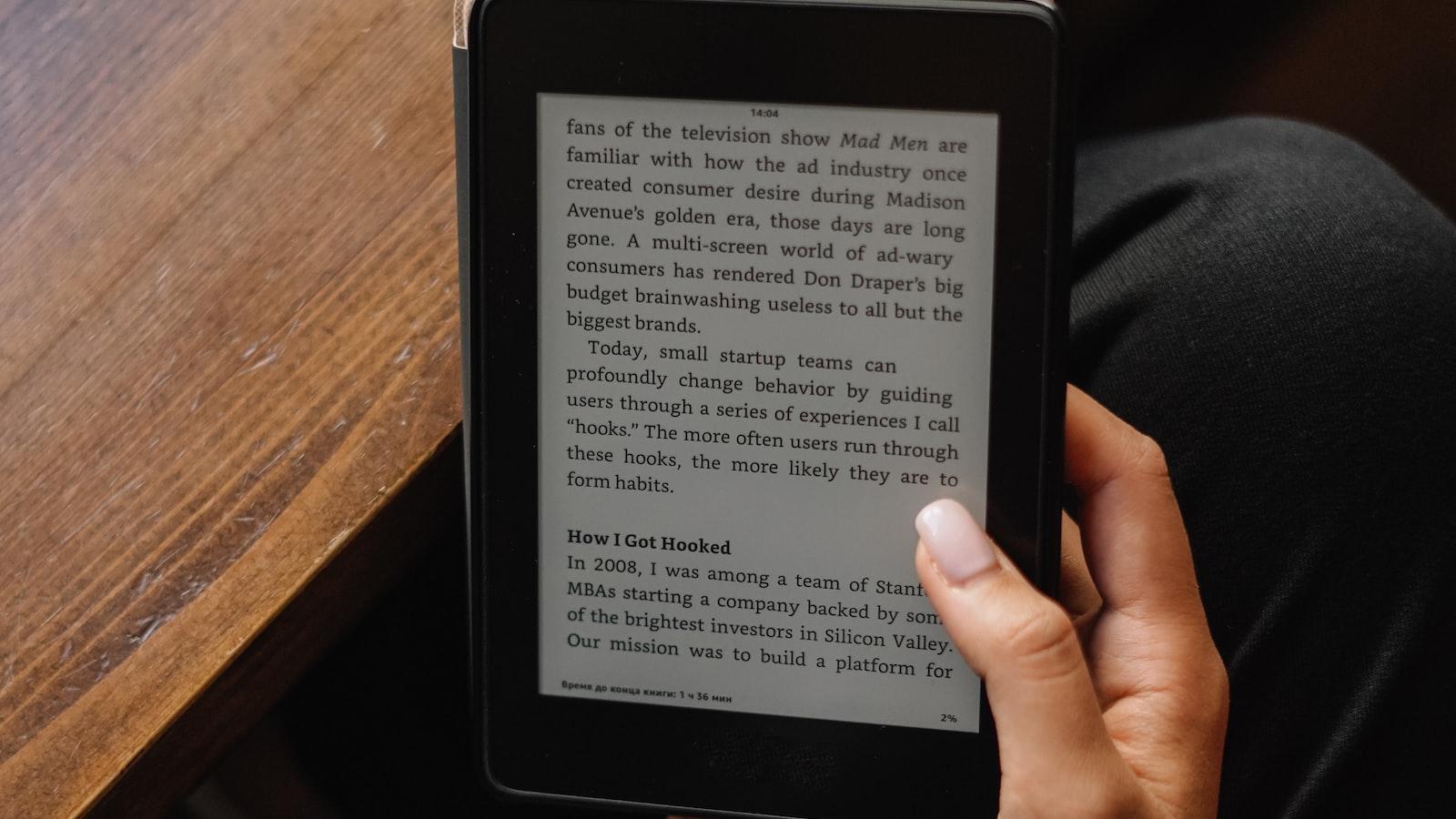Step into a world where words dance on illuminated screens, where entire libraries are cradled in the palm of your hand. Welcome to the realm of e-books, the digital domain that has revolutionized the way we consume literature. As society pushes towards a more technologically-driven future, the debate surrounding the pros and cons of digital reading devices has grown louder. Some herald the convenience and portability of e-books, while others cling to the nostalgic scent of ink and aged paper. In this article, we embark on an odyssey through the vast landscape of the e-book experience, shedding light on the advantages and disadvantages that await those who dare to venture into this digital realm. So, gather close, fellow explorers, as we unravel the secrets of the e-book experience, revealing the ethereal joys and perplexing pitfalls that lie within.
The E-Book Experience Unveiled: Exploring the Pros and Cons of Digital Reading Devices
Digital reading devices have revolutionized the way we consume literature, but like any technology, they come with their own set of pros and cons. One of the most notable advantages of e-books is their portability. Gone are the days of lugging around heavy backpacks filled with textbooks or trying to squeeze multiple novels into a carry-on suitcase. With a digital reading device, you can have an entire library at your fingertips, whether you’re lounging on the couch or on a long-haul flight. Another significant advantage is the ability to adjust the font size and style, making it easier for those with visual impairments or dyslexia to read comfortably. E-books are also often cheaper than their print counterparts, and with the option to borrow digital books from libraries, the cost of reading can be significantly reduced. However, there are some drawbacks to consider. For avid readers, the lack of a tangible book and the smell of freshly printed pages may be a sore loss. Additionally, staring at a screen for prolonged periods can cause eye strain and disrupt sleep patterns. Digital reading devices also require a power source, so if you find yourself in a remote location or during a power outage, your reading options may be limited. Nonetheless, the convenience, accessibility, and flexibility offered by e-books make digital reading devices an increasingly attractive option for book lovers from all walks of life.
– Unveiling the Benefits: How Digital Reading Devices Transform the Reading Experience
Digital reading devices have revolutionized the way we engage with literature, offering a myriad of advantages and a few drawbacks to consider. One key benefit is the convenience of carrying a large library of e-books in a single compact device. No longer do we need to pack bulky novels or search for space on bookshelves. With just one handheld gadget, we can access thousands of titles at our fingertips.
Another advantage of digital reading devices is the flexibility they provide in terms of font size and style. For those with visual impairments or reading difficulties, e-readers allow for customization, enabling individuals to adjust the text size, font style, and even background color according to their specific needs. This feature enhances accessibility and inclusivity in the reading experience.
Additionally, digital reading devices grant readers the convenience of instant access to new releases, bestsellers, and a vast range of genres. With a few simple taps, e-books can be purchased, downloaded, and ready to read in seconds. No more waiting impatiently for physical books to arrive or rushing to the bookstore before they sell out.
However, it is essential to acknowledge the potential downsides of digital reading devices. One drawback is the absence of the tactile sensation and physicality associated with traditional books. The scent of ink on paper, the rustling of pages, and the satisfaction of seeing one’s progress visually are some aspects that cannot be replicated by e-books. Additionally, reliance on technology means the possibility of device malfunctions, battery depletion, or file corruption, compromising the reading experience temporarily.

– Evaluating the Limitations: Overcoming Challenges and Enhancing the E-Book Experience
In a world of constantly evolving technology, e-books have become an increasingly popular choice for avid readers. These digital reading devices offer a multitude of advantages, such as convenience, portability, and the ability to store an entire library within the palm of your hand. However, as with any form of technology, there are limitations that come with the e-book experience. One such challenge is the lack of physicality and tactile sensation that comes with reading a traditional book. The absence of paper pages and the inability to physically flip through them can diminish the overall reading experience for some individuals, as it creates a disconnect from the traditional reading process. Additionally, eye strain and discomfort can be a common obstacle when it comes to e-book reading, particularly for those who spend extended periods of time staring at a screen. Nonetheless, these limitations can be overcome with certain adaptations and enhancements to the e-book experience. Many digital reading devices now offer adjustable fonts and backlighting options, allowing readers to customize their reading experience and reduce eye strain. Furthermore, the development of e-ink technology has provided readers with a more book-like experience, mimicking the appearance of ink on paper and reducing eye fatigue. By acknowledging and finding ways to address these limitations, we can enhance the e-book experience and unlock its full potential. As we conclude our exploration of the pros and cons of digital reading devices, one thing becomes abundantly clear – the e-book experience is an extraordinary phenomenon that has revolutionized the way we engage with literature. Through this journey, we have delved into the captivating world of digital reading, peering into both the shining aspects and the lingering shadows.
In the realm of advantages, we have witnessed how e-books effortlessly ushered in a new era of convenience and accessibility. The ability to carry an entire library in a device lighter than a feather is nothing short of remarkable. The ease of purchasing and instantly downloading books, transcending the barriers of time and distance, allows us to satisfy our literary cravings at any moment. And let us not forget the marvel of adjustable font sizes and customizable displays, which have made reading a pleasure for those with visual impairments. Truly, the digital realm has opened doors for readers young and old, and has embraced the diverse needs of bookworms across the globe.
Yet, as with any groundbreaking innovation, e-books come with their fair share of challenges. The nostalgic scent of paper wafting through bookstores has been replaced by the sterile aura of the pixelated screen. The tangible beauty of physical books, with their dog-eared pages and well-worn covers, stands in stark contrast to the intangible nature of e-books. There is no denying that fervent bibliophiles will forever cherish the weight of a book nestled in their hands and the sound of pages being turned. Furthermore, the ubiquity of distractions on digital devices poses a constant threat to our undivided attention; the allure of social media notifications and app notifications can easily lure us away from the world of literature we so ardently seek.
Ultimately, the e-book experience bears both the shining brilliance of innovation and the gentle nostalgia of tradition. It is a dance between two worlds – the real and the virtual, the tactile and the intangible. The beauty of this experience lies in the fact that it allows us to explore the vast realm of literature in unconventional ways, while still cherishing the traditions that have kindled our love for books.
In conclusion, the digital revolution has not diminished the treasured legacy of books but has rather expanded its horizons. The e-book experience, with all its wonders and quirks, continues to unfold before us like an intricate tapestry. As readers, we have the privilege of venturing into uncharted literary territories, guided by the flickering light of innovation. So, let us embrace this new chapter in reading history, with open arms and open minds, as we immerse ourselves in the alluring world of digital literature.


